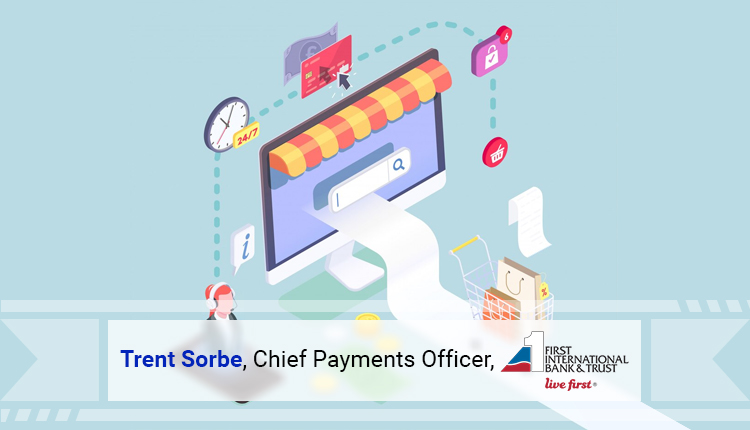By: Trent Sorbe, Chief Payments Officer, First International Bank & Trust
Businesses seeking new ways to attract talent, retain top performers, and keep employees happy must evolve with payments trends. The push for speed and adaptability are at the forefront this year, signaling real-time payments (RTP) should be top-of-mind.
Small business payroll is a perfect use case for adopting RTP. This influence came from the gig economy that initiated the “just-in-time” approach to payroll at the same time the real-time payment rails came to market. As an example, rideshare companies pivoted to these new payment rails much easier than legacy payroll systems. Their contractors, many of whom hold additional full or part-time jobs, got to experience being paid the moment they completed a ride. Those same benefits are being reflected in hourly jobs, which became the impetus of earned wage access (EWA).
The popularity of real-time access to wages, coupled with the difficulty employers have had post-pandemic retaining staff (particularly in service industries), has strengthened the RTP movement. Interestingly, this makes payroll one of the few instances where the supply and demand sides of wages were aligned, creating an ideal environment for payroll innovation.
The Push Toward Instant Payroll
Numerous studies in payroll and EWA point to employee retention and satisfaction rates being linked to accessing wages in real time. A recent industry study reported just 36% of freelancers and consultants are paid most often using instant payment methods, despite it being a preferred payment method by 72% of consumers. Similarly, 78% of consumers reported high satisfaction with instant payment options.
Employers in industries that have historically suffered from high turnover and an inability to attract and retain qualified workers can differentiate their employee perks with instant payments. For example, providing payroll and payout tips for hourly workers – similar to the rideshare model – can allow an employee’s daily pay to be in their bank account seconds after clocking out.
Over 80% of small businesses also rank payment speed as an important requirement, which is driving the appetite for real-time payments. In December 2024, it was estimated that half of U.S. businesses were using real-time payments.
Those numbers should grow exponentially as more financial institutions get onboard with FedNow and The Clearing House RTP Network. More than 1,200 financial institutions are live on FedNow as of late January 2025 while the RTP Network had 840 financial institution participants at the end of 2024.
Read More: Global FinTech Interview with Steve Cover, CTO, iPipeline
The Economic Benefits of Real-Time Payments
Today, employers fund their payroll days ahead of when it is actually received by the employee. This is due to funding risk by the ODFI, along with archaic ACH cutoff times. Many small businesses are also required to fund payroll by wire transfer which is costly and inconvenient.
Like a wire transfer, a real-time payment is also considered “good funds” when received, but at a fraction of the cost. This means credit for receipt does not require that the sending or receiving bank be open or an individual to initiate or monitor for receipt.
In addition to higher employee satisfaction rates, RTP funds can be sent 24/7/365. This means employers can push wages and incentives on demand, allowing for something as easy as a holiday bonus to be paid on the actual holiday.
Employers themselves can also benefit from using RTP to fund their payroll – a concept we refer to as “windowless payroll.” This allows an employer to “push” their payroll funds to the ACH originator/payroll processor one any day and at any hour. The transaction is received without human involvement, at which time, payroll can be initiated and received seconds later. This provides the employer maximum flexibility and helps to avoid having to tie up cash days ahead of payday.
The additional benefit of RTP is that it enjoys solid footing from a regulatory standpoint, especially when compared to EWA that continues to fight off regulatory dust-ups.
The Future of the Real-Time Payments Environment
The RTP environment will continue to force adaptation among payroll processors and the SaaS payroll software providers. In too many cases, payroll technology is antiquated. While this will take time, RTP for many processors appears to be the impetus to upgrade their capabilities and software.
With advances in payroll technology and low-cost ways to push payroll 24/7/365 to employees, pay cycles will become more fluid and in many cases will go to a pure on-demand model, where paystubs, as well as tax withholdings and benefits deductions will be calculated fluidly depending on ad-hoc choices made by the employee.
Looking ahead, we can expect RTP to test the continued adoption of earned wage access, as actual payroll (not advances on accrued wages) becomes available earlier and without requiring adoption of additional financial products, such as prepaid cards, or additional fees to access funds.
Small businesses looking to stay ahead of payment trends that directly impact the well-being and satisfaction of their employers should take note and continue to adapt with today’s instant payment expectations.
About Trent Sorbe
Trent Sorbe joined First International Bank & Trust (FIBT) in 2023 as the institution’s first chief payments officer. With more than 30 years of credit, debit and prepaid cards and payments experience, Sorbe is leading the bank’s payment initiatives, including its Kotapay division, a top 30 ACH originator in 2022 that settled over $102 billion in ACH originations in 2024. He previously held senior positions at four nationwide payment card issuers as well as the FDIC.
Read More: How Financial Institutions Can Effectively Navigate the Implications of CECL
[To share your insights with us, please write to psen@itechseries.com ]
